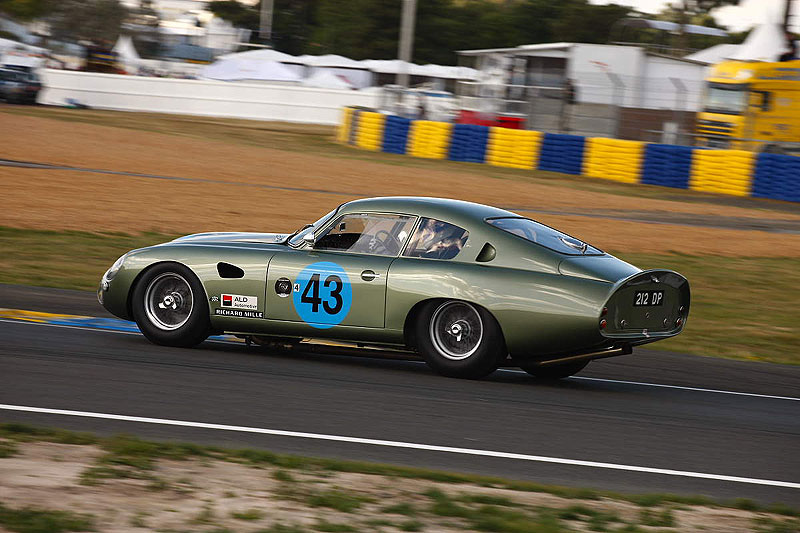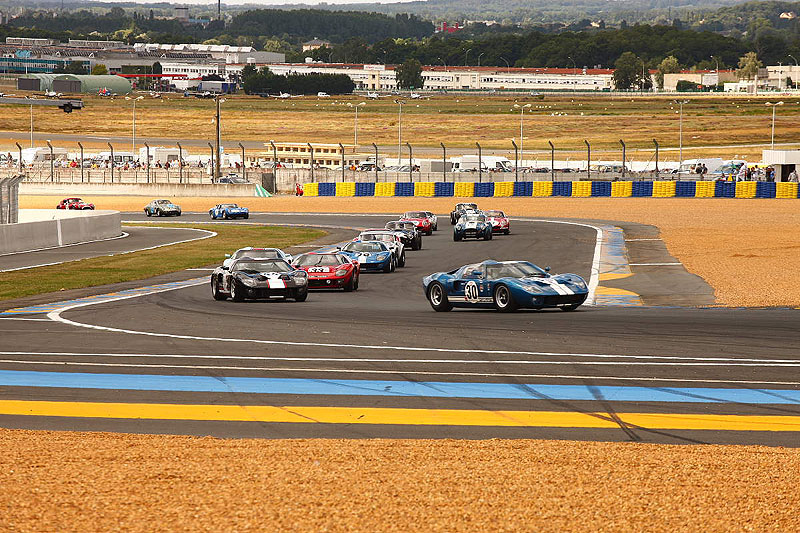
So, you’ve imagined tearing down those long straight Sarthe roads with Kate Moss by your side in your Ferramaslamorsche, and you’ve finally arrived at the Le Mans circuit. Even out of season (ie not the 24 Hours weekend), you’ll find that La Belle Dame of motorsport scrubs up pretty well.
Let’s face it, Silverstone or Misano on a cold wet Monday morning have little attraction, but it’s always a pleasure to return to the dusty flatlands of the Pays de la Loire for the biennial Le Mans Classic, so ably organised by Patrick Peter.
It’s difficult to explain how a long, painted white line in front of the pit garages can contain emotion that reaches bursting point, just before the ‘Controle’ officials allow personnel to cross to the pit wall, but it does. This is a place that has quirks all its own. Every circuit is different and Le Mans is more different than most. Somehow, the French commentator Bruno Vanderstick kept going for the duration, assisted by David Addison, although I hope I’ll be forgiven for thinking I noticed a reduction in the intensity of his output around 03.00-04.00 on Sunday morning.

It’s bizarre how a total lack of sleep doesn’t really make itself felt until after 16.00 on Sunday, when the emotion wells up, whether you are spectator, driver or mechanic. To me, Le Mans is all about extremes: of pitch darkness and early-morning light with almost laser intensity, of a trapped cacophony between pits and grandstands and the distant sound of a V12 being wound out away down the Mulsanne.
Twenty-four hours at the great Sarthe circuit evolves so many different emotions. The circuit itself has, of necessity in these days of ever-increasing safety pressures, been altered considerably, leaving the exit of Tertre Rouge and Arnage virtually the only remaining sections bearing any similarity to the original. But it is still one of the seven wonders of the motorsport world and dramas big and small are played out in largely prototypical fashion. With threatening skies on Thursday, a day before any action took place, the crew of one of the Teutonic racers in Plateau 6, for cars from 1972 to 1979, were meticulously practicing changing from dry to wet-weather tyres. Next day, the car was back on slicks and stayed that way. Maybe, like the rest of us, they ended up by just watching the weather forecast on TV.

Conversely, the Simca saloon that bravely finished in 11th place in 1938 and was down for Renault and Rondeau hero Jean-Pierre Jaussaud to drive seemed to delight in blowing up some major component or other, every time it ventured out onto the hallowed Tarmac. This was all met with almost stoical hilarity and much Gallic shrugging as the team set to and replaced/rebuilt the car – again.


The event seems to inspire a temporary cross-boundary camaraderie, along the lines of we’re-all-going-to-get-through-this-chaps, that sets it apart and makes it a unique experience. Such is the space available within the Circuit des 24 Heures that many classic car clubs from all over Europe, representing over 50 marques, are able to spread themselves around the shorter Bugatti track and enjoy laps around the historic Tarmac.

The races themselves, in a rotating series of six categories or plateaus covering the period of Le Mans from its inception until 1980, were separate Pandora’s Boxes as, with 55 allowed starters, each contained a fabulous mix of cars – as, indeed, did the original races. From Gareth Burnett stamping his obvious authority, speed and exuberance on Plateau 1 right from the start in John Ruston’s Talbot 105 (the French family with whom I was staying told me the story of watching his progress through Arnage at night with rolling eyes and outsretched hands) to the exotic win for the Porsche 936 in Plateau 6, there was plenty to amaze and amuse everyone. Ray Bellm and Christian Glasel in Ford GT40s were both determined to leave La Sarthe with a result but maybe it was the spectators who gain the most from all this, as they can see and experience these cars being made to give their all.
So, two years until the next Classic. Having spoken to some first-timers over the weekend, it seems like 729 days too long.
Text: Peter Collins
Photos: Dino Eisele - all strictly copyright. For further information, visit www.studiodinoeisele.de




























ClassicInside - The Classic Driver Newsletter
Free Subscription!


































